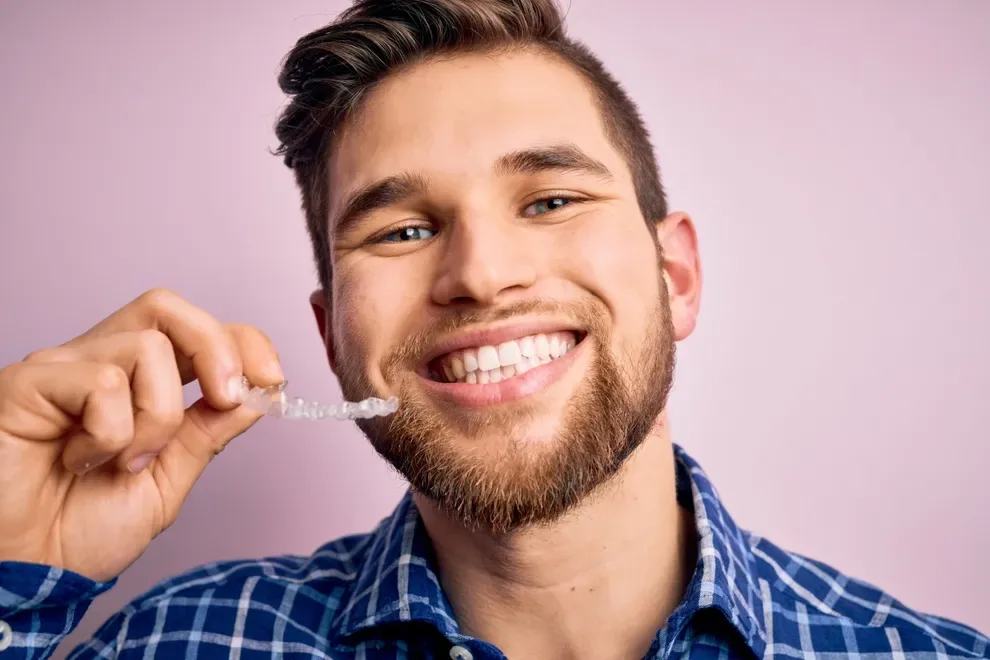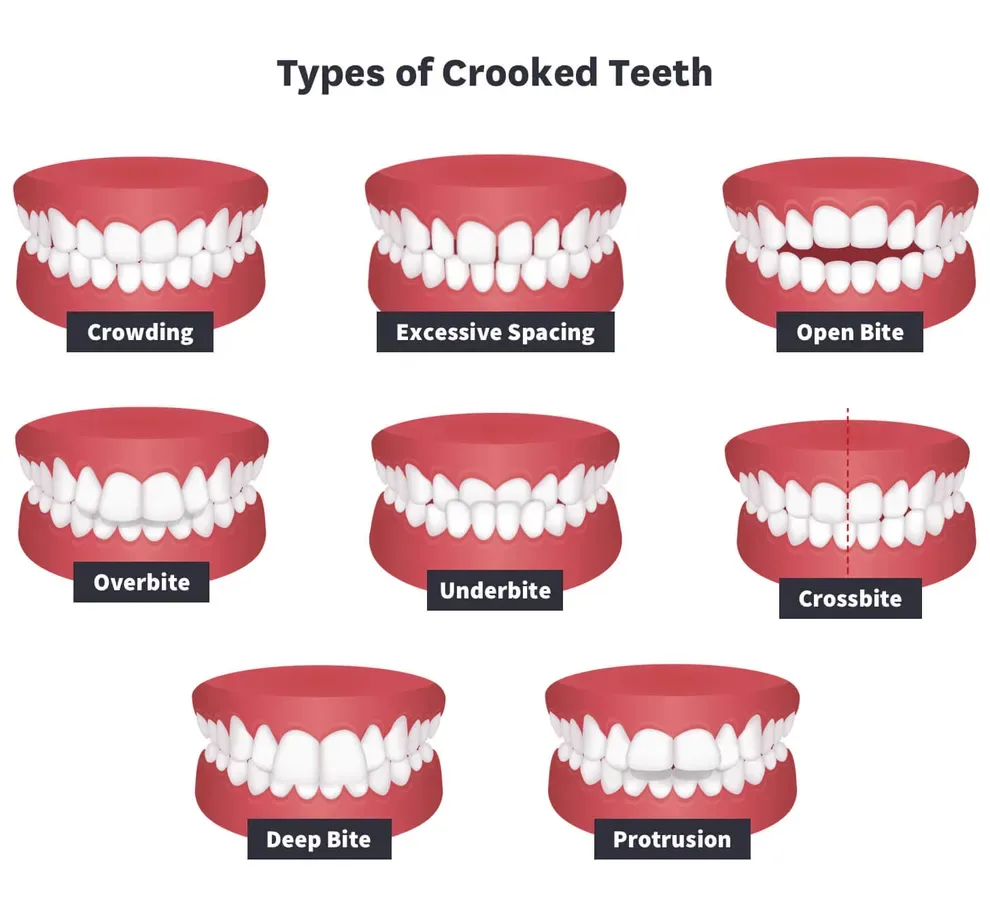How to Fix Crooked Teeth: 4 Ways to Get Straighter Teeth

Table of Contents
- Treating Without Braces
- Treatment Options
- Frequently Asked Questions
- How to Fix Crooked Teeth?
- Benefits of Fixing Crooked Teeth
- What Are Crooked Teeth?
- Fixing Crooked Teeth with Insurance
Even simple things like chewing or smiling can be a chore when your teeth don't fit together properly. The sooner you can improve your smile, the better.
In the past, there was just one way to fix crooked teeth. You'd walk into an orthodontist's office and walk out with metal brackets and wires on your teeth.
Now, you have plenty of options, including these:
Braces
Aligners
Surgery
Cosmetic procedures (like veneers)
The right choice for you will depend on your oral health, your goals, and your budget.
About 90% of people have teeth that are at least slightly out of alignment. If your teeth don't look as straight as you'd like, you're not alone.
Almost 90% of people 20 and older have experienced at least one cavity. Crooked teeth make cleaning tough, and that can lead to advanced decay.
Almost 30% of people don't show their teeth when posing for photos due to their teeth. A crooked set of teeth doesn't always look good in photos.
While fixing crooked teeth can help improve oral health and your smile, about 36% of adults are afraid of dental appointments. Their fears keep them away from solutions that could help.
What Are Crooked Teeth?
These are types of crooked teeth:
Crowding: Brushing and flossing are tough, so your teeth wear down quickly.
Excessive spacing: Food gets caught between your teeth, leading to advanced decay.
Open bite: Your teeth don't come together properly, leading to chips and cracks.
Overbite: Your teeth don't meet, leading to chipping and wear.
Underbite: Your bottom teeth tap the tops, leading to enamel breakdown.
Crossbite: Your uneven bite makes cleaning tough, and your teeth can chip and crack.
Deep bite: Uneven wear leads to cracks and chipping.
Protrusion: Your back teeth grind together, leading to advanced wear and decay.
How Can I Fix Crooked Teeth?
Dental professionals have three main methods available to fix crooked teeth. During an assessment, your team can tell you which option seems right for your smile.
This chart can help you review all your options at a glance:
| Cost | Treatment Duration | Ideal Patient |
Braces | $3,000–$10,000 | 12–36 months | People with moderate to severe cases of crooked teeth |
Aligners | $2,000–$7,000 | 6–18 months | People with mild to moderate cases of crooked teeth |
Surgery | $15,000–$40,000 | 18–36 months (including braces after surgery) | People with severe jaw misalignment issues braces alone can’t fix |
Cosmetic Procedures | $300–$600 per tooth | 1 visit | People with minor gaps or cosmetic issues |
Most people wear braces for 1 to 3 years, and they visit dental professionals in person for adjustments and checkups.
Braces come in many styles, such as these:
Metal: Stainless steel brackets are attached to the front of your teeth and connected by wires and bands.
Ceramic: Brackets are white, like your teeth, and they are connected to the teeth through wires and bands.
Lingual: Brackets are glued to the back, not the front, of your teeth.
The wires are key to the success of braces. With each adjustment appointment, the shape and size of that wire changes, and it works like a tug on all of your teeth.
Your teeth are pulled by pressure on the bracket attached at either the front or the back of your teeth. Orthodontists can use rubber bands to help speed up the process, but the pressure still comes from brackets and wires attached to just one spot.
Aligners look like clear skins for your teeth. They slide right over your teeth and hold tight to the surface. Almost every inch of your teeth is wrapped in this cover, and the pressure comes from all sides.
You'll swap out trays for a new set with a slightly different tooth position every couple weeks. Over time, your teeth will gradually move into the desired placement.
If you're searching for the fastest way to straighten teeth, aligners are the clear winners. Treatment plans typically last for just a few months.
Aligners are so fast due to their design. The trays enclose your teeth completely, and the force comes from all sides. That consistent, wraparound pressure prompts teeth to adjust their position.
Some aligner companies also use proprietary technology that makes faster movement possible. Vibrating tools, for example, are thought to stimulate the cells responsible for tooth movement. Stimulating these cells allows the teeth to safely straighten faster.
Pros & Cons of Aligners
When you've been approved for teeth aligners, you have a decision to make. Examining the benefits and drawbacks of each solution can help you do what's right for your smile.
Braces and aligners differ in the following areas:
Cost: On average, braces cost between $5,000 and $7,000, says Harvard Medical School. Some aligners come with a similar price tag. But direct-to-consumer aligners like Byte cost as little as $2,099. That's a significant savings.
Appearance: Braces stay on your teeth throughout your treatment, and most brackets and wires are easy to spot. Aligners should also remain on your teeth almost all the time, but you can take them out for a critical appointment or conversation.
Comfort: Braces can rub against the tongue and gums, and that metal-to-tissue contact can be painful. Aligners don't cause this sort of discomfort.
Appointments: If you wear braces, you'll need to visit your orthodontist every 3 to 10 weeks. Some forms of aligners also require multiple office visits. But doctor-monitored at-home aligners come with no appointments at all, so you can straighten your smile without upsetting your schedule. Your aligners are mailed directly to your home.
Some people have severely crooked teeth that don't respond to aligners or braces. People like this may need corrective jaw surgery.
Orthognathic surgery (or jaw surgery) involves amending jaw or tooth alignment using surgical tools. Essentially, professionals break, contour, or otherwise manipulate the bones in your smile to fix how your teeth come together and align.
This is a significant surgery that comes with many risks, but for people who haven't gotten better through conventional methods, it can be a good choice.
Can I Fix Crooked Teeth Without Braces?
People with mild cases of crooked teeth may not need braces or aligners at all. Cosmetic techniques can cover up the problem and enhance the way your smile looks.
Cosmetic solutions for crooked teeth include the following:
Veneers: Your dentist glues tooth-colored veneers to the front of your teeth.
Bonding: Your dentist uses tooth-colored materials to close up gaps and make your teeth look straighter.
Whitening: Your dentist uses gels to lighten up stains and make your teeth seem straighter.
Note that none of these methods change how your teeth fit together or in your jaw. But they can help your teeth to look a little better.

How to Fix Crooked Teeth with Insurance
Research from the U.S. Department of Health and Human Services says close to 74% of Americans had dental insurance in 2022. If you’re one of them, you could use your benefits to pay for your tooth straightening work.
Some dental insurance plans include coverage for orthodontic care, including braces and aligners. However, some don’t cover this type of care for people older than 18, and some require patients to pay for at least some of the care out of pocket.
Before you plan on using your dental insurance plan, contact the company and ask for more information. Find out how much the company will pay, how much you’ll have to cover, and if there are caps on how much the plan will pay out.
If your dental insurance won’t pay for care, don’t worry. You could use funds in your health savings account (HSA) or flexible spending account (FSA) to pay for eligible medical expenses, including braces and aligners. Your dental provider may also provide discounts or payment plans to make your care more affordable.
What Are the Benefits of Fixing Crooked Teeth?
It's tempting to consider crooked teeth cosmetic problems. But as the American Association of Orthodontists points out, crooked teeth can lead to significant health issues, including the following:
Added wear
Chipping
Tooth grinding
Pain, including migraines
Fixing crooked teeth can make your smile look better. However, fixing your teeth can also mean reducing the risk of cracked and broken teeth, so you’ll have lower pain levels.
Straight teeth are also easier to clean. You’ll be able to brush your teeth efficiently, and flossing is easier when the threads don’t snag on your teeth. When your smile is straight, your teeth will be easier to clean, and you’ll be less likely to deal with tooth or gum decay.
Which Treatment Option Is Right for You?
The right solution for you varies depending on your oral health and dental condition.
Mild issues: Consider cosmetic solutions. They won't fix the underlying problem, but your treatment will be complete within just a day or two.
Moderate issues: Aligners offer the quickest way to straighten your teeth. Pick the right product, and you might also save money and have a more comfortable experience as your teeth move.
Severe issues: If aligners don't work due to the severity or complexity of your teeth placement issues, traditional braces or surgery might be better options. While they may take longer and could potentially cost more, you'll be able to achieve the smile you want.
Take your time and investigate your options. Your smile is important. And this is a big decision you shouldn't take lightly.
Fixing Crooked Teeth Frequently Asked Questions
Your smile is important, and choosing the right solution for crooked teeth isn't always easy. These are common questions people often ask:
There are no natural or DIY methods safe for your crooked teeth. Work with an orthodontist or surgeon to get the smile you want. Choose an unauthorized treatment, and you could undermine the health of your teeth.
Aligners are a non-braces solution for crooked teeth. Clear trays are safe, effective, and hard for others to see. You can also try cosmetic procedures, such as bonding or veneers.
Aligner companies use telemedicine techniques to connect you with qualified help. You won't have to leave your home to get the smile you always wanted.
Your treatment time really depends on how crooked your teeth are. A method that seems "fast" to one person could be totally inappropriate for someone else.
Talk to your dentist about what to do next. Some people benefit from treatment with at-home aligners, but others can use veneers or bonding to fix one tooth that's out of line.
Unfortunately, your price will vary depending on the solution you need. Mild cases are less expensive to fix than severe problems. Talk to your dental professional about your teeth and learn more about what form of treatment might be best for you.
